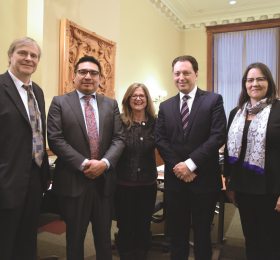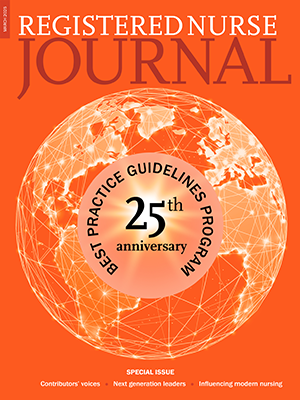High turnover a small blip for Bluewater
Higher staff turnover at Sarnia’s Bluewater Health is said to be a result of the shift to a younger workforce says Shannon Landry, the organization’s chief nursing executive. “Probably one of the biggest increases we’ve seen is the number of maternity leaves,” she says. A recent report from the hospital’s human resources department says half of Bluewater staff (more than 1,700 people) are millennials, born between 1977 and 1995. Parental leaves have gone from about 100 in 2015 to more than 130 for each of the past two years. That number is expected to continue to climb, notes Landry: “We are right now anticipating and looking at our staffing and our scheduling to ensure we…have that flexibility.” The demographic shift to a younger workforce, she adds, is common across the health-care sector. The overall turnover rate at Bluewater stands at 9.6 per cent, up from 6.7 per cent five years ago. That rate also includes retirements and resignations, but Landry is not worried. Bluewater sees 18,000 to 20,000 job applications per year, she says. (The Sarnia Observer, March 20)
Ontario must fund life-saving health services
A letter by RNAO CEO Doris Grinspun was published in the Ottawa Citizen (April 5). In response to the province’s announcement to defund Ottawa Public Health’s (OPH) drug consumption site, RNAO is calling on the provincial government to restore funding for OPH as well as two other sites in Toronto.
Given the reality that a poisoned drug supply is killing thousands of Canadians, Ottawa Public Health’s (OPH) drug consumption site is helping to keep people alive. The OPH site is a necessary resource that allows the City of Ottawa to provide its residents with a safe, hygienic space to use intravenous drugs and be supported in accessing addiction treatment and other services.
The Registered Nurses’ Association of Ontario calls on the provincial government to heed the evidence, consult front-line staff and organizations responding to overdoses every day, and fund these life-saving health services. The lives of our loved ones, colleagues, clients and neighbours hang in the balance.
New mobile app for youth mental health patients
St. Joseph’s Health Care London has launched a pilot project to connect local youth with mental health-care professionals. The TELEPROM-Y mobile app allows patients and their health-care team to talk via secure video link, message back-and-forth, and schedule in-person appointments. Providers can also send questionnaires and advice to patients electronically. “Mental health services are all about relationships,” says Cheryl Forchuk, project lead and research chair for Lawson Health Research Institute, part of London Health Sciences Centre and St. Joseph’s Health Care London. “In our previous work with youth, they talked about how they really wanted to see the technology they use (daily) integrated into the care they’re receiving. This is really what our goal has been,” Forchuk says. The program includes 120 people who are 16 to 25 years old and living with symptoms of anxiety and/or depression. The two-year project will evaluate how well the mobile app is received, and whether it reduces the number of youth mental health hospitalizations and outpatient visits. (The London Free Press, Feb. 7)
Stroke survivor helps others
For RN Susan Robertson, a busy hockey mom, nothing was out of the ordinary. She was constantly on the go, taking her kids to practices or weekend tournaments for hockey and baseball. Then, at 37, she had a stroke. “I first went to the clinic with a sore left arm. They thought it was an arterial clot, so I went to the hospital,” she says. “When I got there I had multiple pulmonary embolisms. I knew what was happening (in the emergency department), but lost the use of everything. I couldn’t speak,” she recalls. Robertson stayed in the hospital for three weeks and didn’t fully recover her speech, mobility, or full use of her right side until a year later. The experience was frightening, she says. Now, thanks to a new program called Peers Fostering Hope, launched in Windsor in March, stroke survivors can meet with other survivors so they do not feel alone during recovery. Robertson has become a volunteer with the program, and hopes to help others going through the same thing she did. “I will be able to share my story and listen to theirs. I can provide support and give them hope that there is life after a stroke.” (Windsor Star, Feb. 13)
Call for more focus on immunization
With a measles outbreak in New York City last fall, and a number of confirmed cases in B.C. early this year, public health initiatives are more crucial than ever. The importance of immunization programs for children was a topic of discussion for Haldimand and Norfolk Health and Social Services in February as students in the area faced suspension for incomplete immunization records. The Immunization of School Pupils Act (ISPA) requires students in primary and secondary school to be immunized against diseases such as tetanus, polio, measles and mumps, or have a valid exemption on file. “It is thanks to these vaccines that diseases that were the leading cause of death 100 years ago now cause less than five per cent of all deaths in Canada,” says RN Sarah Titmus, the Haldimand and Norfolk Health Unit’s program manager for infectious disease. In 2017-18, the compliance rate in Haldimand and Norfolk was 83 per cent for 17-year-olds compared to 88 per cent the previous year. Titmus says the decrease can be attributed to an increase in the number of vaccines required (up from six to nine). “Ongoing immunization programs that ensure high coverage rates are needed to maintain low levels of vaccine-preventable diseases,” she says. (Simcoe Reformer, Feb. 13)
Health system transformation
Ontario Health Minister Christine Elliott announced on Feb. 26 that the provincial government hopes to make it easier for patients to navigate the health system by creating a central agency called Ontario Health (see more on pages 6, 10 and 17). “Nurses have been calling out our system’s failings for years. It needs to be more attentive to people, better connected, easier to navigate and more cost effective,” says RNAO President Angela Cooper Brathwaite. The new legislation, if passed, will fold 20 existing provincial health-care agencies into Ontario Health. These include Cancer Care Ontario, Health Quality Ontario, e-Health Ontario, Trillium Gift of Life Network, and HealthForceOntario. Direct services, including some provided currently by Local Health Integration Networks (LHIN) will be devolved to health providers who will work as members of local Ontario Health Teams (OHT) that bring together service providers in primary care, acute care and home care. (The Manitoulin Expositor, March 6)
Learning about concussions
To raise awareness about concussion and its related symptoms, Nipissing University nursing students Jacob Belanger and Selena Sciuk led a one-hour presentation to Grade 12 biology students in February to talk about how to identify a concussion, and what to do if you have one. As part of a pilot program called Brain Waves – a partnership between Nipissing’s nursing students and a national injury prevention charity called Parachute Canada – the pair addressed students at North Bay’s St. Joseph-Scollard Hall. They shared insight about symptoms, long-term effects, and standards for concussion treatment. “Concussion awareness is crucial in this population to ensure they are seeking proper assistance following head trauma to avoid long-lasting effects and complications,” Belanger says. Student athletes often carry a sense of pride in remaining physically healthy and uninjured, he says, which can lead to not reporting symptoms. Brain Waves was launched to inform high school students about the different parts of the brain and injury prevention. (North Bay Nugget, Feb. 27)
Advocating for improvements in long-term care
RNAO was among a number of stakeholders invited to attend two days of roundtable sessions Jan. 23 and 24 with Justice Eileen Gillese, the commissioner appointed to oversee the Long-Term Care (LTC) Homes Public Inquiry. The inquiry was tasked with examining the events that led to the crimes of former RN Elizabeth Wettlaufer, who is now serving a life sentence for murdering eight seniors and attempting to murder six others. RNAO CEO Doris Grinspun and LTC best practice guideline senior manager Suman Iqbal attended the meetings.
RNAO was the first to call for a public inquiry when the crimes of Wettlaufer came to light. And the association was granted status at the inquiry. In September 2018, RNAO – represented by Henein Hutchison lawyer Lauren Binhammer – presented its recommendations to Justice Gillese as part of the inquiry. Its submission noted that significant systemic issues in LTC must be addressed by the health ministry if it wants to ensure seniors who live in nursing homes are safe and secure. RNAO highlighted the urgent need to change current funding and staffing models.
It also recommends reporting obligations and follow-up action for nurses and nursing homes be clarified on issues of resident safety.
The inquiry’s final report is expected in late July. For more information about the inquiry, visit longtermcareinquiry.ca. RNAO’s submission can be found under the “public hearings” tab. RN
Budget priorities
A committee of MPPs is getting advice on what should be included in the next provincial budget. RNAO CEO Doris Grinspun and the association’s senior economist Kim Jarvi presented RNAO’s policy priorities during a Jan. 29 meeting of the Standing Committee on Finance and Economic Affairs.
The association’s submission included 21 recommendations focused on improving access to nursing and health care, strengthening the health system, boosting living standards, protecting the environment, and creating a fairer tax system.
In nursing and health care, RNAO urges that hospitals be provided with dedicated funding to immediately post and fill 10,000 RN positions that are vacant. And to ensure the right nurse is in the right place – given patients’ complex care needs – there are recommendations mandating that all new hires in acute care and cancer care hospitals be RNs; and that all first home care assessments be conducted by RNs.
RNAO’s submission also emphasizes the importance of ensuring health providers work to their full scope of practice, including measures that authorize RNs to order diagnostic tests for common ailments (such as sore throats and urinary tract infections) and prescribe medications. It also suggests the removal of barriers that prevent NPs from practising to their full scope, such as point-of-care testing.
In her presentation, Grinspun told the government’s finance committee that the health system must be strengthened by modernizing the archaic funding models that hobble the long-term care sector and penalize nursing homes when they improve resident outcomes.
RNAO says all nursing home residents would be better served by homes adopting best practices that address care around issues such as falls prevention, wound care, and the use of restraints.
As it related to Indigenous peoples, RNAO calls on the Ontario government to support Indigenous peoples’ right to self-determination. Grinspun also spoke about the need to expand access to consumption and treatment services to all communities in need.
When it comes to the environment, RNAO says the government must recognize that climate change is already affecting the health of people in the province. It wants the government to develop a climate change plan that would reduce greenhouse gas emissions. The province must also work with its federal and municipal counterparts to ensure transit expansion as well as measures to encourage cycling and walking.
RNAO says that the revenue to pay for its recommendations can be found if the government adopts a more progressive tax system and requires polluters to pay for the full cost of the pollution they create, including carbon emissions.
This year’s budget is expected in early spring. For a summary of RNAO’s recommendations, visit RNAO.ca/policy/submissions.
New organization launched to advocate for homeless
A new network of advocates focused on people who are homeless in Toronto has come together to create the Shelter and Housing Justice Network (SHJN). Two RNAO members sit on the group’s steering committee: street nurses Cathy Crowe and Roxie Danielson. As a front-line RN at Toronto’s Inner City Family Health Team, Danielson does outreach work with people who do not have a place to live and says she has clients who prefer to live outside because of the shortcomings of the current shelter and respite system. While she is glad the system is there, she admits it could be a lot better. SHJN is using a two-prong approach to combat the shelter and housing crisis. Its first objective is to expand the shelter system, which needs 2,000 additional shelter beds. Another goal is to provide more affordable, supportive housing. “On one hand, it’s really positive that the shelters and respite (centres) are there, because they get people off the streets and connected to resources,” Danielson says. The downfall, she suggests, is overcrowding and insufficient staffing.





